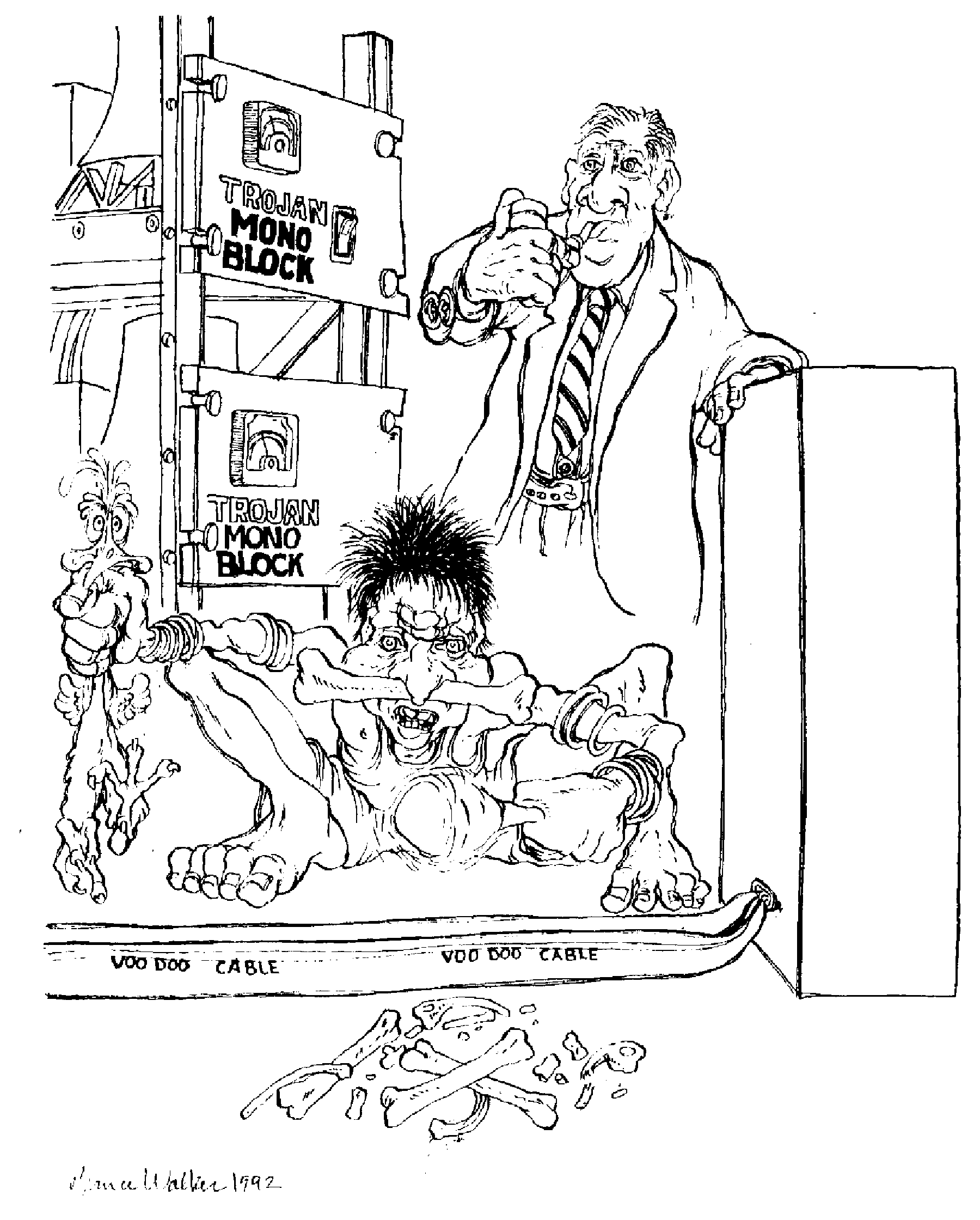Roger Skoff writes about how systems really work, and why that can be a problem

Roger Skoff (photograph and image processing by David W. Robinson)
Many years ago, upon learning that my sister had no home music source other than her television set and a table radio, I decided to buy her a stereo system.
It was her birthday, and I wanted her to have something that she could enjoy, but buying a system—even a modest one—can be expensive (or even wildly expensive, depending on what you want and how much you're willing to pay for whatever level of audio nirvana is required), so the first decisions I had to make were how much to budget overall, and how much of the available budget to allocate to each of the elements of the system that I would buy her.
One thing I knew was that she I wasn't an audiophile, so the ultimate in imaging and "You're right there" realism wouldn't be required—just a pleasant and enjoyable presentation would be fine. Another thing was that, because all she would be doing was listening to it, not making it her hobby, she wouldn't likely be making any changes, and would leave it just the way she got it.
That meant that I could use a "compensating flaws" approach to optimizing whatever system I selected for her, and could, if I did a good job of it, save some money and still get decent results.
The idea of "compensating flaws" is really quite simple: All it means is that, in assembling your system, you use a weakness in one thing to cancel-out an opposite weakness in another. For example, if one component is too "dark" sounding—lacking in highs or upper frequency extension or detail, you can offset or even cancel that flaw entirely by using another component somewhere in the system that's equally too "bright"—that has a "peaky" or overemphasized high end. Similarly, if something is a little too "etched-sounding" or "hard-edged" (reviewers politely call it "analytical"), you can compensate for it by using something with a little "duller" or "sweeter-sounding" presentation (reviewers call that "musical"), and usually save the day.
That's what I did for my sister's system and, for the modest amount of money I spent (only $500 total, but things were a lot cheaper back then), I was able to put together something that actually sounded pretty good, and that gave her many years of listening satisfaction.
The use of compensating flaws as a cheap and easy fix may be just fine where funds are limited or where you're dealing with a non-hobbyist listener, but what about music lovers or audiophiles who have the budget; are willing to commit it; and are looking for not just a pleasant sound, but a reasonable approximation of reality? That's an entirely different situation, and under those circumstances, compensating flaws may not be the solution to a problem, but the problem, itself.
As a cable manufacturer (first XLO, and now RSX), I've always tried to design cables for every application that are as "neutral-sounding" as possible—meaning that, to the extent that it can be done, they neither add nor subtract anything from the signal they pass nor distort it in any way. ( In fact, everything affects the sound of a system in one way or another—from the power coming out of the wall to the cable that carries it; to the electronics and cables that bring the musical signal to the speakers; to the speakers, themselves; and to the room that it's being played in—so that's an impossible goal.) The consensus of reviewers and audiophiles over the years is that I've done that pretty well, but even so, the cables I've designed have been accused of being everything from too dark, to too bright, to too analytical, to too musical, and even of being too "system-dependent."
How can that be?
The answer is simple: Compensating flaws. But in this case the flaws are elsewhere in the system, and that makes for a problem, not only for me and every other High-End audio manufacturer seeking to market products intended to be truly neutral-sounding, but also for every audiophile or music lover trying to create a genuinely neutral-sounding system. (Incidentally, it's also a problem that manufacturers regularly run into, and have to overcome in trying to sell to new dealers, and that those dealers, themselves, face in trying to help customers to choose new systems or upgrade existing ones.)
To understand it, consider the following entirely reasonable possibility: What if a good sounding system in an acoustically near-perfect listening room (the ideal dealer's salon, for example) included, in addition to a full complement of perfectly neutral other components, just one component that was way over-bright and uncomfortably "analytical"? (I'm sure we can all think of at least one brand that might fit that description.) And what if the system also included just one "way-too-dark" and excessively "musical" cable (we probably know one of those, too) that would perfectly offset that one bright component and create a false impression of total-system neutrality?
In a case like that, to change the "dark" sounding cable for one that was neutral would certainly produce an instant and clearly audible change, but the change would be no improvement. Instead of being "neutral-sounding," as it had been before, the system would suddenly become too bright, and a listener, hearing the difference, would almost certainly believe that it was the new cable that had caused it!
He'd be right, too, but for the wrong reason. And, to make it even worse, for as long as he continued to believe it, his incorrect (though, at first glance, entirely reasonable) explanation for the system's sudden new brightness might very well keep him from ever finding out its real cause and fixing it.
The real reason for the new brightness is not that the new cable is too bright—as I said, the one put in is actually neutral-sounding. Instead, it's compensating flaws again, but only in reverse: By removing the dark cable that was compensating for the bright other component, the compensation is gone and the other component's brightness is revealed, only to be blamed on the neutral new cable!
It's the same sort of thing with "system dependence." Any component, cables included, is supposed to sound different in different systems! If it doesn't, that means that it has its own sonic "coloration," and that it's imposing it on every system it's put into—definitely not what you want if what you want to hear is the music instead of just the sound of that one thing!
It's perfectly okay to use complementary flaws in one element of a system to "cancel out" the flaws in another, but if you're going to do that, at least do it with full knowledge of what you're doing and the conviction that your action is the best way to accomplish what you're trying to achieve. That's what I did for my sister and that's what an equalizer is for: It's a device to create tailored frequency response peaks or valleys to correct for "flaws" in an original recording or just to make it sound "better," and the engineers who record the music we love use them more often than you might think. Making corrections isn't the problem. It is figuring out what the problems really are that's the problem!
One of the biggest problems that people can have in setting up a system is to remember that it is a system, and that no single part of it can ever be listened-to or judged all by itself. What does a speaker sound like if it's not attached to an amplifier, a preamp, and a source? Or if any one of the cables is missing along the way—even the ones that plug things into the wall for power? The same applies to every other element of the system, and the result, because of that, is that the only way to ever find out what any one element of your system sounds like is to listen to it and to each of the other system elements before and after it, substituting them wherever possible to see what consistent effect they have on the sound of that system and on whatever other systems may be available. When you find one that sounds one way in one system and another way in another, good! That may be the neutral one, and be the one you want to keep!
Using system components that have little or no coloration of their own will deny you the opportunity to use compensating flaws to offset other system problems, but will also—if that's what you're seeking—bring you closer to the reality of the music you love than any other approach.
It will also mean that, when you go to change any component in your system for whatever reason, you'll actually hear what you're getting, and may not need to spend more money to buy more things to compensate for undoing the compensation you had before.
So, there's a little light on the subject that, hopefully, won't make things too bright. Happy playing with your system!






































